Jellyfish in UK waters
Marine Conservation Society (MCS)
Partner organisation of the Watches
What do barrel, moon and mauve stinger have in common? They’re all types of jellyfish that you could spot in UK waters
Did you know that you can find jellyfish in the UK’s seas? It's most likely to be in the summer months, as jellyfish ‘blooms’ arrive as the water warms.
At the Marine Conservation Society, we’re interested in what jellyfish are found in UK waters. We started our jellyfish survey in 2003, with the intention of understanding more about the distribution of jellyfish in our waters and how this affects leatherback turtles.
Leatherbacks migrate to UK waters to feed on jellyfish through the summer. However, with limited data on where these blooms happened, we wanted to gather data to identify potential feeding hotspots for leatherback turtles.
But what jellies can you expect to spot at the seaside?
Here’s 8 to keep an eye out for, and be sure to report them to us at the Marine Conservation Society via our
How to identify different jellyfish:
Lion's mane (Cyanea capillata)
This jellyfish stings. Large, usually 50cm but can reach 2m in diameter. Large, reddish brown, umbrella-shaped bell with a mass of long, thin hair-like tentacles as well as short, thick, frilled and folded arms.
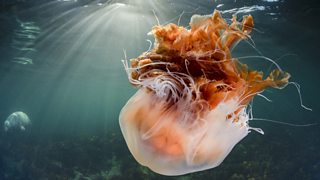
Lion's mane jellyfish by Kirsty Andrews, MCS
Blue (Cyanea lamarckii)
Up to 30cm, similar shape to the Lion's mane jellyfish but smaller with a blue bell through which radial lines can be seen. A yellow colour variant also occurs in UK waters. Mild sting.
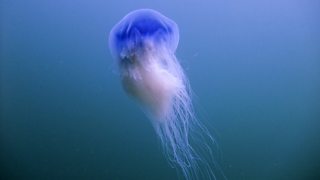
Blue jellyfish by Peter Bardsley, MCS
Compass (Chrysaora hysoscella)
Typically up to 30cm. Colour variable, but usually has pale umbrella-shaped bell with brownish V-shaped markings, 32 marginal lobes and 24 long, thin tentacles, four long, thick, frilled arms hang from the manubrium.
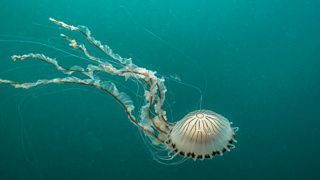
Compass jellyfish by Peter Bardsley, MCS
Moon (Aurelia aurita)
Up to 40cm in diameter. Transparent, umbrella-shaped bell edged with short hairlike tentacles. Recognised by the four distinct pale purple rings in the bell. Manubrium (mouth and arms, underside and centre of bell) bears four short, frilled arms. Mild sting.
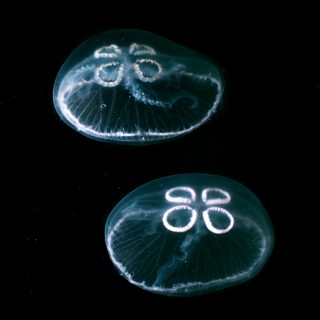
Moon jellyfish by Mark Kirkland, MCS
Mauve stinger (Pelagica noctiluca)
This jellyfish stings. Up to 10cm. Has a deep bell with pink or mauve warts, 16 marginal lobes and eight marginal, hair-like tentacles. Manubrium bears four longer frilled arms with tiny pink spots.
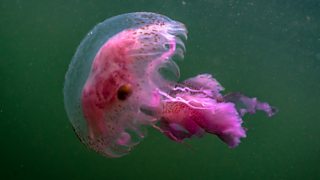
Mauve stinger by Peter Bardsley, MCS
By-the-wind-sailor (Velella velella)
Not a jellyfish but a floating, solitary hydranth. Up to 10cm long and blue-purple in colour. Upright sail and chitinous float with a mass of small tentacles surrounding the mouth on the underside. Found in vast swarms.
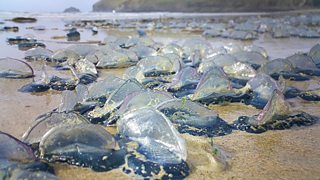
By the Wind Sailor by Jonathan Smith
Portuguese man-of-war (Physalia physalis)
This animal stings. Not a jellyfish, but a floating colony of hydrozoans. The oval-shaped, transparent float with crest is characteristic. Blue-purple in colour, with many hanging ‘fishing polyps’ below that may be tens of metres long. Extremely dangerous to humans due to their powerful sting. Rare in the UK but if many are found be sure to report to the local authorities.

Portuguese Man o War by Joanna Clegg, MCS
As a result of these , with partners from the University of Exeter we published the first paper from the survey data, confirming key information about UK jellyfish and including the first distribution maps of the surveyed species.
The paper confirmed that adult barrel jellyfish have a largely western distribution in UK seas and can survive UK winters (so you might see one on your winter walks!). The paper also identified south-west England and Wales as a jellyfish hotspot, where other work has shown a relatively high probability of leatherback turtle sightings for the UK.
